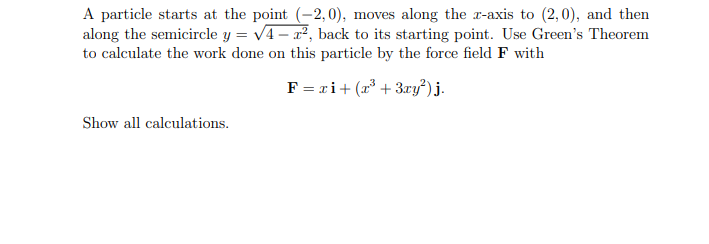

- EXMAPLES OF CLAULCULATING THE WORKDONE ON A PARTICEL FULL
- EXMAPLES OF CLAULCULATING THE WORKDONE ON A PARTICEL FREE
Are There Different Forms of Kinetic Energy? These vibrations are kinetic energy at work since they are moving.

Heat is created by molecular vibrations within objects, with faster vibrations equaling higher temperatures. Is Heat Kinetic Energy?Īlso known as thermal energy, heat energy is kinetic in nature.
EXMAPLES OF CLAULCULATING THE WORKDONE ON A PARTICEL FULL
However, when devices are shut off, even while charging, they are full of potential energy, not kinetic. Electrical devices that are turned on use kinetic energy as do people moving about the house. This could be a cue ball rolling on a billiards table, a fan circulating air on a warm day, or glass shattering on the floor after it falls from the counter. Examples of Kinetic Energy at HomeĪnything at home that moves is an example of kinetic energy. Below are some more specific examples of kinetic energy in everyday life - and some examples of different forms of kinetic energy.
EXMAPLES OF CLAULCULATING THE WORKDONE ON A PARTICEL FREE
There are countless examples of kinetic energy, both in free movement and in the form of electrical energy, which comes from the potential energy stored in electrons. If you’re looking to find the kinetic energy of a non-electrical object, the equation for kinetic energy is KE = 1/2 m v2, where m is the mass and v2 is the square of its velocity. However, this figure can vary depending on the electric company. This unit can be used to determine everyday energy usage in the form of electricity by a simple conversion :ġ kilowatt-hour (kWh), which is how electricity is measured in households, is equivalent to 3.6 million Joules.įor reference, most Americans pay about 12 cents per kWh of electricity, so it costs about $1 for about 30 million Joules of kinetic energy in an average household. A Joule is equal to the force of one Newton (N) acting along a length of one meter. Kinetic energy is measured in the same units as all types of energy: Joules (J). There are countless examples of kinetic energy at work in the real world: roller coaster rides, cars driving downhill, skydiving, hitting a golf ball, throwing a curling rock go on the ice, and any other time something is actively moving anywhere in the world. Kinetic energy is never present in an object at rest - only in objects that are moving. The main characteristics of kinetic energy are movement and moving objects. What Are the Characteristics of Kinetic Energy? The total kinetic and potential energy together is known as mechanical energy. This results in a potential energy decrease and kinetic energy increase. Kinetic energy is created when potential energy is released, triggered into motion by gravity or chemical reactions, among other catalysts. In chemical energy, the stored potential energy in molecular bonds is released as kinetic energy. Gravitational energy, as the name suggests, is the energy potential of objects that is released when Newtonian gravity pulls them towards the Earth. In everyday life, two of the main catalysts of kinetic movement are gravitational potential energy and chemical energy. Kinetic energy is really the converted potential energy found in all objects and dictated by forces of motion. The most important factors that determine kinetic energy are the motion (measured as velocity) and the mass of the object in question. The total kinetic energy of an object depends on several factors, such as the amount of work done on an object and its acceleration after a moment of inertia from external forces. Understanding kinetic energy is intuitively easier than understanding potential energy because it’s more obvious that moving things have energy.

It is one of the two main forms of energy, along with potential energy, which is the stored energy contained within objects at rest. Kinetic energy (KE) is the energy of a body in motion, which means it’s essentially the energy of all moving objects. What Is Kinetic Energy and What Does It Mean? Get ready to learn everything you need to know about kinetic energy and how it applies to your everyday life. This is shown in perhaps the most famous equation in history: E=mc2, where m is mass and c2 is the speed of light (or more precisely, the square of the speed of light). Energy is also another form of mass, with relativity showing that mass and energy could be interchangeable by using the speed of light as a constant. But before you can have kinetic energy explained, you must first understand energy as a concept.Įnergy is the ability to do work - it’s when a force is applied to an object and it moves. Kinetic energy may sound like a complicated term, but it’s actually quite simple.


 0 kommentar(er)
0 kommentar(er)
